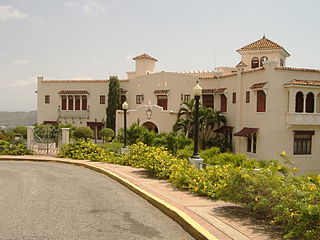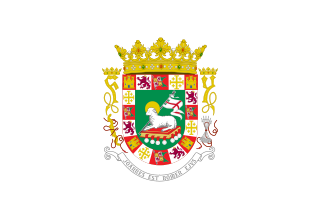
Puerto Rico, officially the Commonwealth of Puerto Rico, is a self-governing Caribbean archipelago and island organized as an unincorporated territory of the United States under the designation of commonwealth. Located about 1,000 miles (1,600 km) southeast of Miami, Florida, between the Dominican Republic in the Greater Antilles and the U.S. Virgin Islands in the Lesser Antilles, it consists of the eponymous main island and numerous smaller islands, including Vieques, Culebra, and Mona. With approximately 3.2 million residents, it is divided into 78 municipalities, of which the most populous is the capital municipality of San Juan. Spanish and English are the official languages of the executive branch of government, though Spanish predominates.

San Juan is the capital city and most populous municipality in the Commonwealth of Puerto Rico, an unincorporated territory of the United States. As of the 2020 census, it is the 57th-largest city under the jurisdiction of the United States, with a population of 342,259. San Juan was founded by Spanish colonists in 1521, who called it Ciudad de Puerto Rico.

Puerto Ricans, most commonly known as Boricuas, but also occasionally referred to as Borinqueños, Borincanos, or Puertorros, are an ethnic group native to the Caribbean archipelago and island of Puerto Rico, and a nation identified with the Commonwealth of Puerto Rico through ancestry, culture, or history. Puerto Ricans are predominately a tri-racial, Spanish-speaking, Christian society, descending in varying degrees from Indigenous Taíno natives, Southwestern European colonists, and West and Central African slaves, freedmen, and free Blacks. As citizens of a U.S. territory, Puerto Ricans have automatic birthright American citizenship, and are considerably influenced by American culture. The population of Puerto Ricans is between 9 and 10 million worldwide, with the overwhelming majority residing in Puerto Rico and mainland United States.

Ponce is a city and a municipality on the southern coast of Puerto Rico. The most populated city outside the San Juan metropolitan area, Ponce was founded on August 12, 1692 and is named after Juan Ponce de León y Loayza, the great-grandson of Spanish conquistador Juan Ponce de León. Ponce is often referred to as La Perla del Sur, La Ciudad Señorial, and La Ciudad de las Quenepas.

Bayamón is a city, municipality of Puerto Rico and suburb of San Juan located in the northern coastal valley, north of Aguas Buenas and Comerío; south of Toa Baja and Cataño; west of Guaynabo; and east of Toa Alta and Naranjito. Bayamón is spread over 11 barrios and Bayamón Pueblo. It is part of the San Juan-Caguas-Guaynabo Metropolitan Statistical Area and the second most populous municipality in both the metropolitan area and Puerto Rico.
The municipalities of Puerto Rico are the second-level administrative divisions in the Commonwealth of Puerto Rico. There are 78 such administrative divisions covering all 78 incorporated towns and cities. Each municipality is led by a mayor and divided into barrios, third-level administrative divisions, though the latter are not vested with any political authority. Every municipality is governed as stated by the Autonomous Municipalities Act of 1991, which establishes that every municipality must have an elected strong mayor with a municipal legislature as the form of government. Each legislature must be unicameral, with the number of members related to adequate representation of the total population of the municipality. In contrast to other jurisdictions, both the mayors and the municipal legislators are elected on the same date and for the same term of four years in office.

Territories of the United States are sub-national administrative divisions overseen by the federal government of the United States. The American territories differ from the U.S. states and Indian reservations as they are not sovereign entities. In contrast, each state has a sovereignty separate from that of the federal government and each federally recognized Native American tribe possesses limited tribal sovereignty as a "dependent sovereign nation". Territories are classified by incorporation and whether they have an "organized" government through an organic act passed by the Congress. American territories are under American sovereignty and, consequently, may be treated as part of the U.S. proper in some ways and not others. Unincorporated territories in particular are not considered to be integral parts of the U.S., and the U.S. Constitution applies only partially in those territories.
Commonwealth is a term used by two unincorporated territories of the United States in their full official names, which are the Northern Mariana Islands, whose full name is Commonwealth of the Northern Mariana Islands, and Puerto Rico, which is named Commonwealth of Puerto Rico in English and Estado Libre Asociado de Puerto Rico in Spanish, translating to "Free Associated State of Puerto Rico." The term was also used by the Philippines during most of its period under U.S. sovereignty, when it was officially called the Commonwealth of the Philippines.

The governor of Puerto Rico is the head of government of the Commonwealth of Puerto Rico, and commander-in-chief of the Puerto Rico National Guard.

Throughout the history of Puerto Rico, its inhabitants have initiated several movements to gain independence for the island, first from the Spanish Empire between 1493 and 1898 and since then from the United States. Today, the movement is most commonly represented by the flag of the Grito de Lares(Cry of Lares) revolt of 1868.

The Senate of Puerto Rico is the upper house of the Legislative Assembly of Puerto Rico, the territorial legislature of Puerto Rico. The Senate, together with the House of Representatives of Puerto Rico, control the legislative branch of the government of Puerto Rico.
The Puerto Rico national football team represents Puerto Rico in men's international football, and are governed by the Federación Puertorriqueña de Fútbol (FPF). The team's nickname is El Huracán Azul meaning The Blue Hurricane. They are members of the Caribbean Football Union, and part of CONCACAF. The team has never qualified for the FIFA World Cup or the CONCACAF Gold Cup.

The World Wrestling Council is a professional wrestling promotion based in Puerto Rico. It was originally established as Capitol Sports Promotions in 1973 by Carlos Colón, Victor Jovica, and Gorilla Monsoon. By the mid-1990s, the promotion had changed its name to the World Wrestling Council. It was a member of the National Wrestling Alliance until 1988. WWC is among the oldest professional wrestling promotions in the world and one of only eight in the entire world to reach its 50th anniversary in continuous operation.

Juan Cristóbal Gundlach was a German-Cuban naturalist and taxonomist.
This is a list of properties and historic districts that are listed on the National Register of Historic Places (NRHP) in Puerto Rico, not to be confused with the Puerto Rico Register of Historic Sites and Zones. There are more than 375 listings in Puerto Rico, with one or more listing in each of Puerto Rico's 78 municipalities.

The history of Puerto Rico began with the settlement of the Ortoiroid people before 430 BC. At the time of Christopher Columbus's arrival in the New World in 1493, the dominant indigenous culture was that of the Taíno. The Taíno people's numbers went dangerously low during the latter half of the 16th century because of new infectious diseases carried by Europeans, exploitation by Spanish settlers, and warfare.

The Puerto Rico statehood movement aims to make Puerto Rico a state of the United States. Puerto Rico is an unincorporated territorial possession of the United States acquired in 1898 following the Spanish–American War, making it "the oldest colony in the modern world". As of 2023, the population of Puerto Rico is 3.2 million, around half the average state population and higher than that of 19 U.S. states. Statehood is one of several competing options for the future political status of Puerto Rico, including: maintaining its current status, becoming fully independent, or becoming a freely associated state. Puerto Rico has held six referendums on the topic. These are non-binding, as the power to grant statehood lies with the US Congress. The most recent referendum was in November 2020, with a majority (52.52%) of those who voted opting for statehood.

The Commonwealth of Puerto Rico is an unincorporated territory of the United States. As such, the archipelago and island of Puerto Rico is neither a sovereign nation nor a U.S. state.

The flag of Puerto Rico, officially the flag of the Commonwealth of Puerto Rico, represents Puerto Rico and its people. It consists of five equal horizontal stripes, alternating from red to white, with a blue equilateral triangle based on the hoist side bearing a large, sharp, upright, five-pointed white star in the center. The white star stands for the island, the three sides of the triangle for the three branches of the government, the blue for the sky and coastal waters, the red for the blood shed by warriors, and the white for liberty, victory, and peace. The flag is popularly known as the Monoestrellada (Monostarred), meaning having one star, a single star, or a lone star. It is in the Stars and Stripes flag family.

Hurricane Maria was an extremely powerful and devastating tropical cyclone that affected the northeastern Caribbean in September 2017, particularly in the U.S. territory of Puerto Rico, which accounted for 2,975 of the 3,059 deaths. It is the deadliest and costliest hurricane to strike the island of Puerto Rico, and is the deadliest hurricane to strike the country of Dominica and the territory of the U.S. Virgin Islands. The most intense tropical cyclone worldwide in 2017, Maria was the thirteenth named storm, eighth consecutive hurricane, fourth major hurricane, second Category 5 hurricane, and deadliest storm of the extremely active 2017 Atlantic hurricane season. With over 3,000 deaths and a minimum central pressure of 908 millibars (26.8 inHg), Maria was both the deadliest Atlantic hurricane since Jeanne in 2004, and the eleventh most intense Atlantic hurricane on record, respectively. Total monetary losses are estimated at upwards of $91.61 billion, almost all of which came from Puerto Rico, ranking it as the fourth-costliest tropical cyclone on record.












